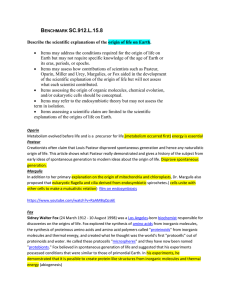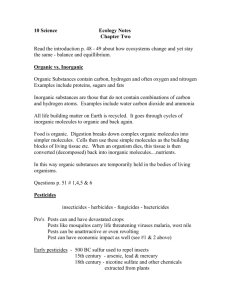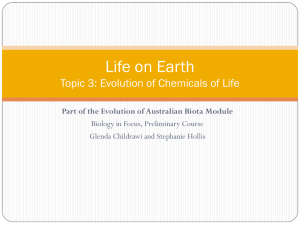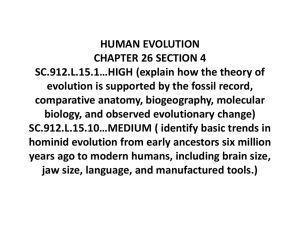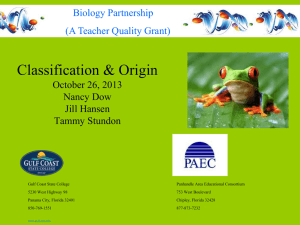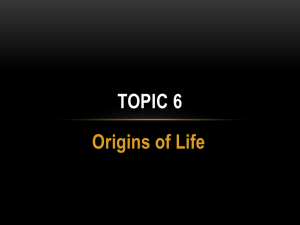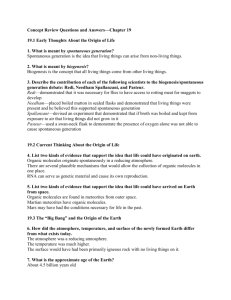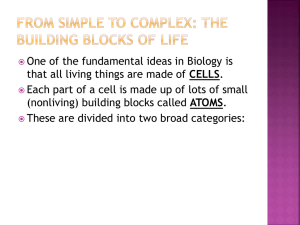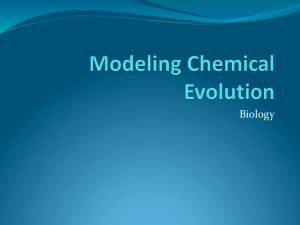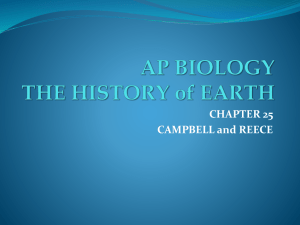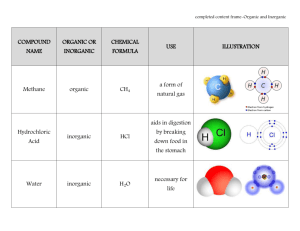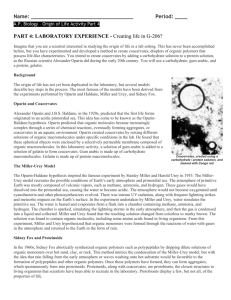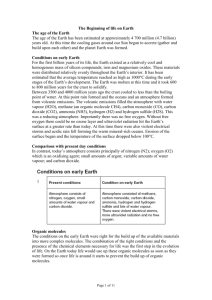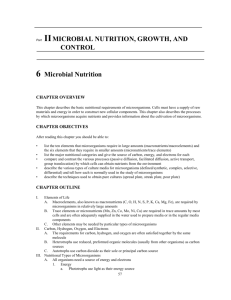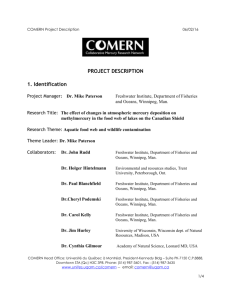ORIGIN OF LIFE SC.912.L.15.8
advertisement
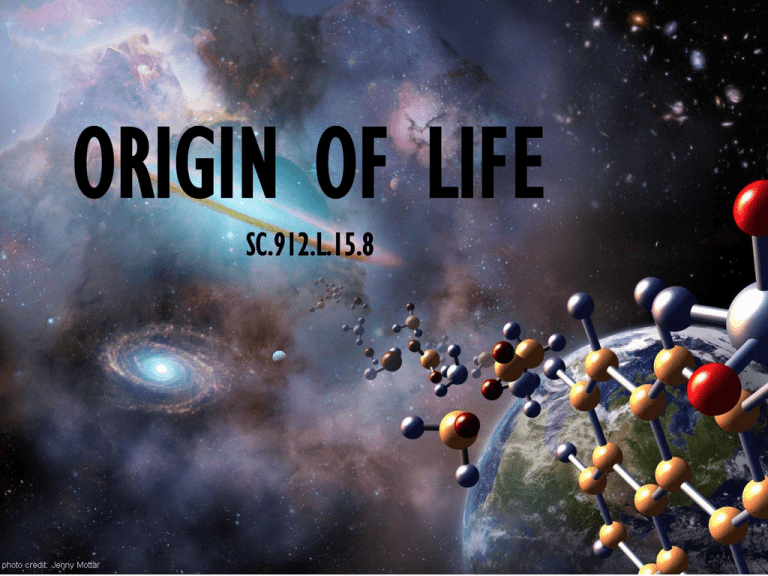
ORIGIN OF LIFE SC.912.L.15.8 Intro • This presentation is on benchmark SC.912.L15.8 which covers the origin of life on Earth. • Origin of life research is the study of the beginnings and early development of life. • We will also learn about scientific contributions from a few scientist. Scientific explanation of the origin of life on Earth • Science shows us that the universe evolved by self-organization of matter towards more and more complex structures. • The most common hypothesis in the scientific community, is that life began approximately 3.5 billion years ago as the result of a complex sequence of chemical reactions that took place spontaneously in Earth's atmosphere. Scientific Explanations • The earliest known life on Earth existed between 3.9 and 3.5 billion years ago. • In the science community there have been many hypothesis thrown around to figure out how did life occur. • But we can all conclude that it all started with a cell. Louis Pasteur Contributions • Prior to the 1860s, when Louis Pasteur developed his germ theory of disease, the common consensus was that life could spontaneously generate. Today we know new life won't generate out of nothing, but this is due largely to Pasteur's work. Pasteur showed us that microorganisms, incapable of detection by human senses, live everywhere around us. Ironically, science has come back to explore this very concept as a possibility once more as one of two main competing explanations for the origin of life on Earth. No one can be sure which one adequately explains the origin of life on Earth, but amazingly, both have been shown to be possible. Alexander Oparin Contributions • Oparin was primarily interested in how life initially began. There is no fundamental difference between a living organism and lifeless matter. Oparin thought that the infant Earth had possessed a strongly reducing atmosphere, containing methane, ammonia, hydrogen, and water vapor. In his opinion, these were the raw materials for the evolution of life. In this process biological orderliness already comes into prominence. Competition, speed of cell growth, survival of the fittest struggle for existence and, finally the natural selection determined such a form of material organization which is characteristic of living things of the present time. Oparin outlined a way in which basic organic chemicals might form into microscopic localized systems possible precursors of the Cell from which primitive living things could develop. While Oparin himself was unable to do extensive experiments to investigate any of these ideas, scientists were later able to. The Miller Urey Experiment • In the 1950's, biochemists Stanley Miller and Harold Urey, conducted an experiment which demonstrated that several organic compounds could be formed spontaneously by simulating the conditions of Earth's early atmosphere. They designed an apparatus which held a mix of gases similar to those found in Earth's early atmosphere over a pool of water, representing Earth's early ocean. Electrodes delivered an electric current, simulating lightning, into the gas-filled chamber. After allowing the experiment to run for one week, they analyzed the contents of the liquid pool. They found that several organic amino acids had formed spontaneously from inorganic raw materials. Their experiments, along with considerable geological, biological, and chemical evidence, lends support to the theory that the first life forms arose spontaneously through naturally occuring chemical reactions. However, there are still many skeptics of this theory who remain unconvinced. Lynn Margulis Contributions • Margulis is best known for her theory on the origin of eukaryotic organelles, and her contributions to the endosymbiotic theory, which is now generally accepted for how certain organelles were formed. • While her organelle genesis ideas are widely accepted, symbiotic relationships as a current method of introducing genetic variation is something of a fringe idea. Sidney Fox Contributions • A biochemist responsible for discoveries on the origins of life. Fox explored the synthesis of amino acids from inorganic molecules, the synthesis of proteinous amino acids and amino acid polymers called "proteinoids" from inorganic molecules and thermal energy, and created what he thought was the world's first "protocells" out of proteinoids and water. Fox believed in spontaneous generation of life and suggested that his experiments possessed conditions that were similar to those of primordial Earth. In his experiments, he demonstrated that it is possible to create protein-like structures from inorganic molecules and thermal energy. Dr. Fox went on to create microspheres that he said closely resembled bacterial cells and concluded that they could be similar to the earliest forms of life. • • • As for the first, three scenarios have been proposed: organic molecules were synthesized from inorganic compounds in the atmosphere rained down on earth from outer space; were synthesized at hydrothermal vents on the ocean floor. • Chemical evolution: The formation of complex organic molecules from simpler inorganic molecules through chemical reactions in the oceans during the early history of the Earth; the first step in the development of life on this planet. The period of chemical evolution lasted less than a billion years. • A eukaryote is an organism whose cells contain complex structures enclosed within membranes. Which takes a big part in the building blocks of life. • The endosymbiotic theory postulates that several key organelles of eukaryotes originated as symbioses between separate single-celled organisms. According to this theory, mitochondria and plastids and possibly other organelles--represent formerly free-living bacteria that were taken inside another cell as an endosymbiont. What did I review? • You reviewed the many hypothesis and making of the origins of life on Earth.
